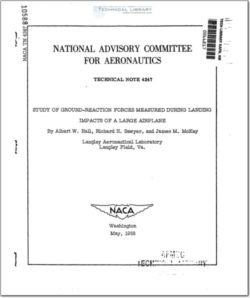NACA-TN-4247

- Version
- 176 Downloads
- 1.23 MB File Size
- 1 File Count
- December 4, 2015 Create Date
- December 4, 2015 Last Updated
National Advisory Committee for Aeronautics, Technical Notes - Study of Ground Reaction Forces Measured During Landing Impacts of a Large Airplane

Some results are presented of tests conducted on a large bomber—
type airplane to determine the ground-reaction forces imposed on the
main landing gear under actual landing conditions. The data were obtained
from 30 landings made at vertical velocities up to 8.h feet per second
and at forward ground speeds from 81.0 to 119.5 knots on both wet and
dry concrete runways.
The vertical force on the landing gear truck at which the oleopneu-
matic shock strut began to compress varied over a wide range. There
appeared to be no relation between this breakout force and any other
force or condition of the impact.
The computed variation of maximum vertical force with vertical veloc-
ity agreed reasonably well with the experimental results.
Frequently there was an unequal division of the vertical force on
the two wheels of a truck, which resulted in unsymmetrical drag forces
particularly during the time when one wheel had spun up and the other
was still in the process of spinning up.
The mean value of coefficient of friction for the dry runway varied
from 0.40 at the beginning of spin-up to a maximum value of 0.72 at a
slip ratio of 0.15. The mean value of coefficient of friction for the
wet runway varied from 0.20 at the beginning of spin—up to a maximum
value of O.hl at a slip ratio of 0.07.
In the low vertical-force range, the side force varied with drift
angle and vertical force. At high vertical forces, side force varied
primarily with drift angle and further increase of vertical force had
little effect on side force at a given drift angle.
The need for a more accurate knowledge of the loads imposed on the
landing gear has become increasingly important in the structural design
of airplanes. Prediction of dynamic structural loads on the landing
gear and on the airplane is possible by a number of methods of dynamic
analysis which permit reasonable accuracy in the calculation of the
dynamic response when the forcing functions are known. In order to
obtain information on these forcing functions, the ground forces imposed
on the main landing gear of a large airplane under actual landing condi-
tions were measured. The main landing gear of this airplane was equipped
with strain gages and linear and angular accelerometers in order to meas—
ure ground—reaction forces during landing impacts.
| File | Action |
|---|---|
| naca-tn-4247.pdf | Download |

Comment On This Post